HISTORIC STRUCTURES OF SOUTHOLD TOWN
_______________________________________________________________
 Founders Landing Monument, Southold, Dedicated in 1915
Founders Landing Monument, Southold, Dedicated in 1915
Established patterns of seventeenth century migration dictated that men would come first from England in order to assess the dangers and possibilities of the New World and to prepare the way for women and children…. By the time the Reverend John Youngs, “organized his church anew” and left New Haven with his followers in October of 1640, it is highly probable that the men of the group had been in Southold for some time, preparing shelter and planting crops for the hard winter ahead….
— Antonia Booth, Southold Town Historian.
~~~~~~~~~~~~~~~~~~~~~~~~~~~~~
Houses of the Seventeenth Century
All of Southold’s 17th-century houses, standing today, were similar in form and layout. Their arrangement had a centered entrance on the main facade, leading to a narrow staircase set in front of the chimney. To the right was the parlor (the largest room), and to the left, the kitchen, also called the hall. The second floor chambers (bedrooms) were similar in size and shape to the rooms below.
The house was supported on large stones situated under each post. The stones were of glacial origin, found locally. The cellar was small, stone lined, and not an integral part of the foundation.
The heavy oak frame, hewn rather than sawn, had interlocking joints secured with pegs, and was exposed inside the rooms. Summer beams were used in the ceilings of the main rooms to shorten and stiffen the joists of the second floor. The floor joists, and the floor boards fastened to them, were exposed in these houses. Plaster was not available until the end of the 17th century.
A large fireplace served each principal room, with all feeding a common flue in the central chimney. The kitchen fireplace was the largest, perhaps as much as 8 feet wide, with a bake oven situated in the back wall.
The characteristic placement of doors, windows and chimneys, mark these houses as belonging to the 17th-century. The pattern is of three elements, for example, the three upstairs windows that balance the facade. In the next century, the Georgian style predominated. The pattern changed to five elements, again balanced across the facade….
— Houses of Southold.
___________________________________________________________________
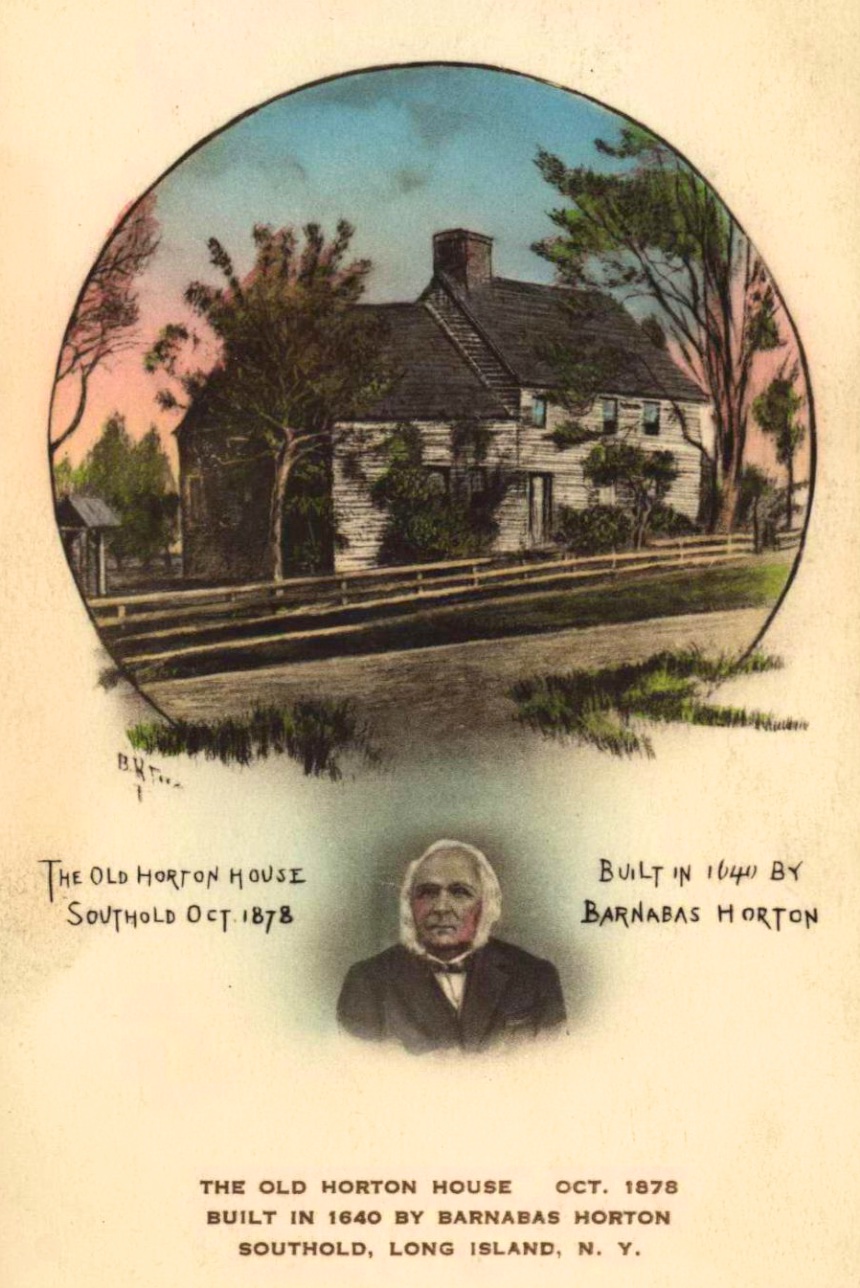
Archival postcard courtesy of the Southold Free Library Whitaker Historical Collection.
~~~~~~~~~~
Barnabas Horton
Barnabas Horton was a native of Mouseley in Leicestershire. He was one of the outstanding first settlers of Southold in 1640 who was a baker by trade as well as an overseer of the town. A man of property is evidenced by his holdings that fill three entire pages of the Southold Town Records, including selling his interest in Plum Island on May 12, 1666. He was constable, and deputy in the New Haven Court, among other positions. One of his first sons, Caleb, was the first child born in the Settlement. Barnabas and his sons were wealthier than any other family in Southold. Barnabas Horton died in Southold on July 13, 1680.
— Dan McCarthy, Archivist at the Southold Free Library Whitaker Historical Collection and the Southold Historical Society.
___________________________________________________________________

 The Old House, before 1649
The Old House, before 1649
Perhaps the oldest building of English heritage still standing in the State of New York, the Old House, restored to its original appearance in 1940, is one of America’s best 17th-century houses. Its important period characteristics include its high, rectangular mass, surmounted by the plastered chimney, its clapboarded walls and its restored doors and windows….The roof of the Old House was very steep, in part because construction using heavy rafters and thatch required good runoff for rain and melting snow, but also because the enclosed space provided sleeping space for a large family. The rafters were joined to the upper plate to prevent spreading and the shingles or other roof covering were terminated at the house line with almost no overhang….
— Houses of Southold.
___________________________________________________________________
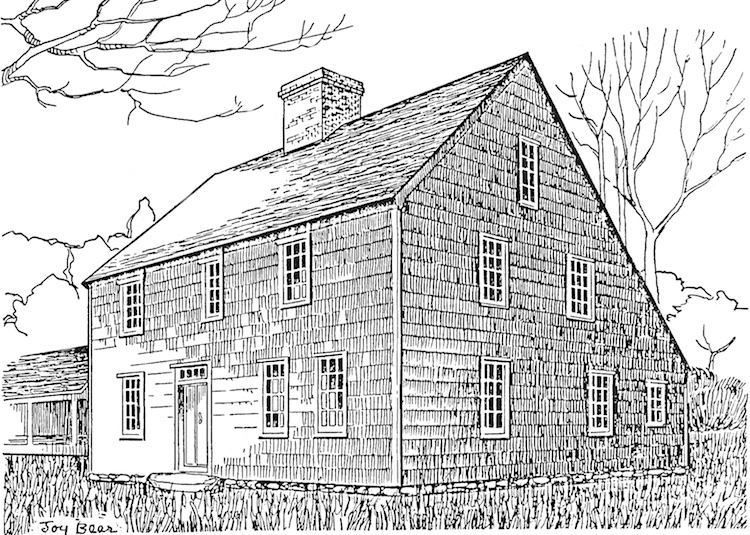
Terry-Mulford House, before 1672
The Terry-Mulford House is similar in form and plan to the Old House, but there are important differences. The slightly later lean-to wing has been preserved, giving the house the typical ‘salt-box’ profile associated with houses of this age, particularly in New England. Instead of studs to carry clapboards (or shingles) on the outside and lath and plaster on the inside, leaving a hollow core, heavy planks formed the walls. They were placed vertically from the sill to the girt and from the girt to the upper plate. The planks that made the walls were nailed to the frame, and the exterior and interior wall claddings were attached to them. Because the walls were thinner than those built with studs, the window frames project out from the walls….
— Houses of Southold. Illustration by Joy Bear.
___________________________________________________________________

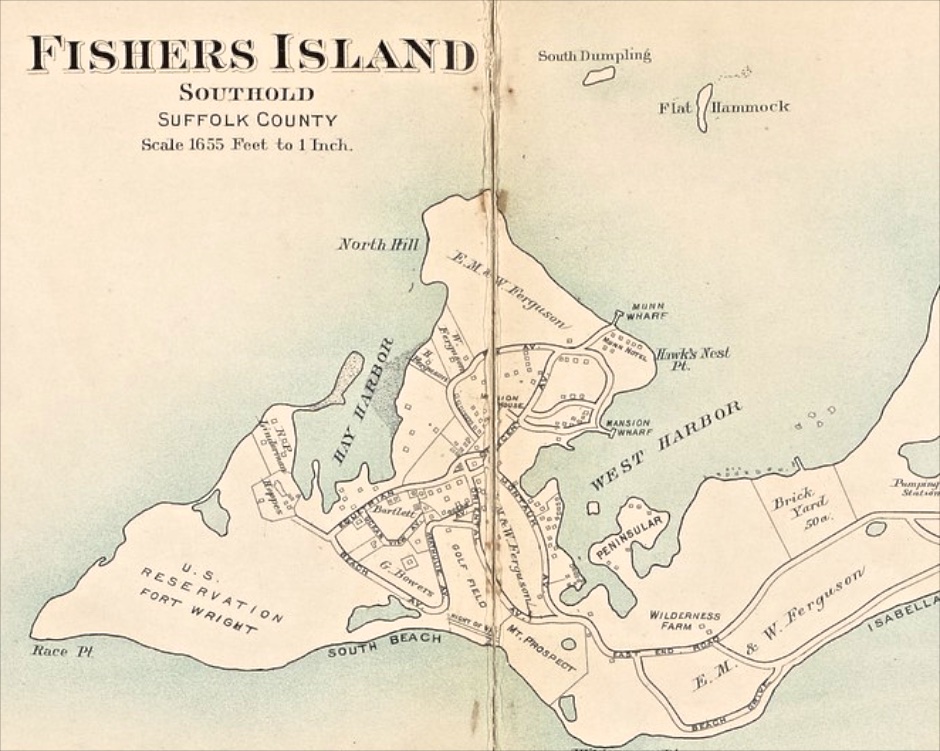
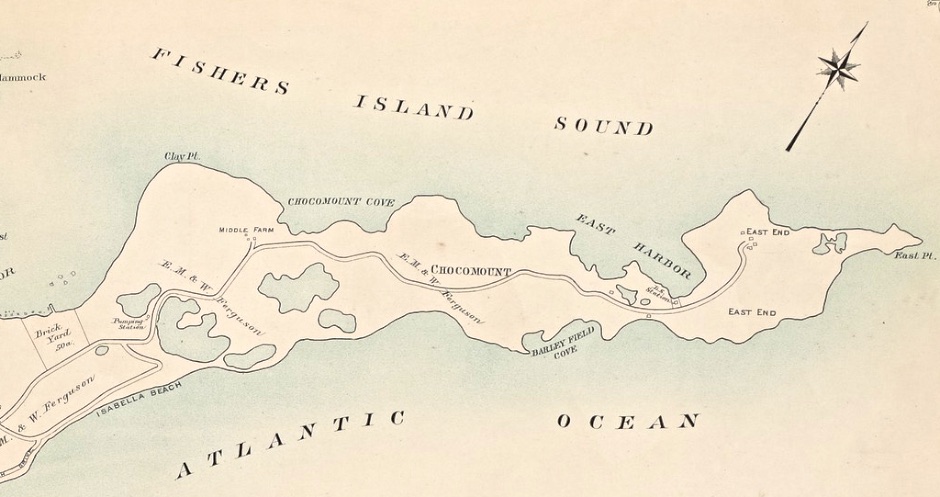
Plum & Fishers Islands become part of Southold Township in 1676. Maps published by E. Belcher Hyde, issued 1902 – 1909. Courtesy of the New York Public Library Digital Collection.
___________________________________________________________________
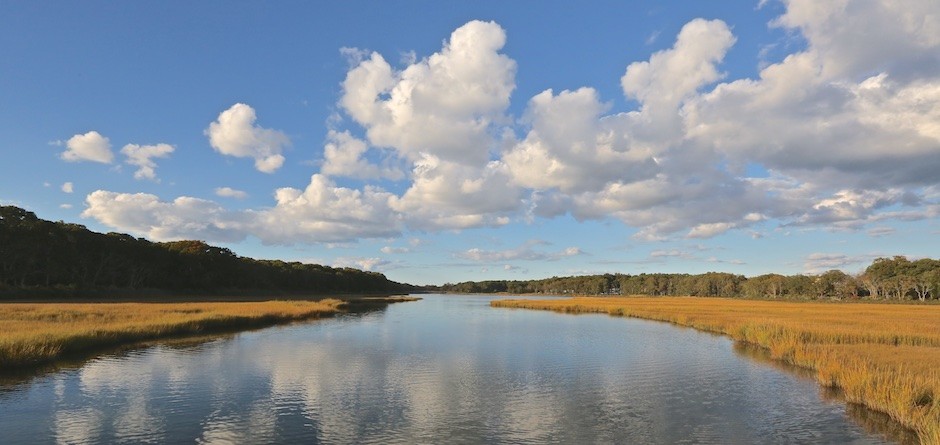
Downs Creek, Cutchogue
———————–

Downs Farm Preserve at Fort Corchaug
___________________________________________________________________
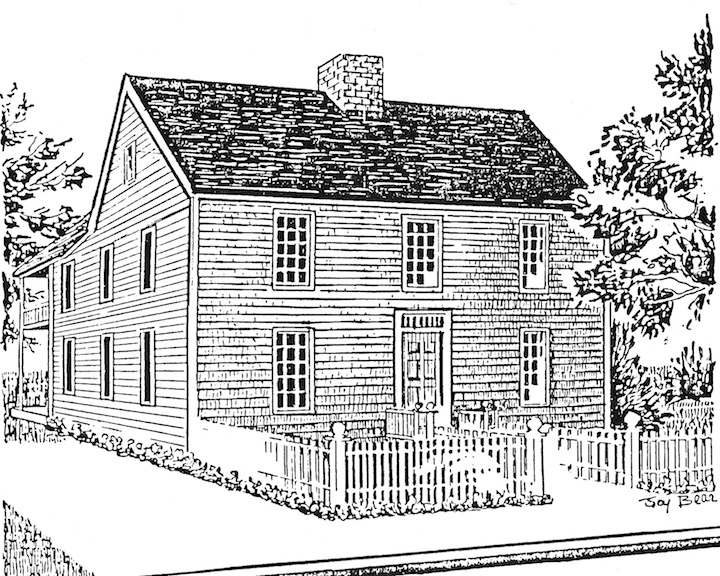
Revolutionary Cottage, c. 1730
Revolutionary Cottage is a two-story center-entrance, center-chimney house. Its style is of the 17th century rather than later because it has only one window on each side of the front door, instead of the paired windows typical of the 18th-century style, and only three second-story windows. This facade pattern is termed “three-bay,” although in this period “five-bay” indicating five upstairs windows, would be more typical. The height of the frame and its one-and-a-half-room depth are carryovers from the 17th-century….
— Houses of Southold. Illustration by Joy Bear.
___________________________________________________________________
Houses of the Eighteenth Century
~~~~~~~~~~~~~~~~~~
Georgian Houses
The Georgian style was formal, and designs were drawn according to rules of correct proportion, quite a contrast to the rugged informality of 17th-century buildings. While the high styles of London, colonial seaport cities, or even the Connecticut valley did not directly appear in Southold, local builders did feel their influence. They gave greater emphasis to symmetrical and balanced facades, large double-hung sash windows with squared panes, paneled doors (rather than battened vertical boards) and often added a row of glass lights above the main entrance door.
In the early 18th-century, two major house forms appeared. These are the single-story Georgian-style house and the full two-story classic form. The single-story house varied in form, depending on how the attic was to be used. If more attic headroom was needed, a knee-wall was incorporated in the front and back walls of the house. This could increase the roof height as much as three feet. Sometimes small windows pierced the knee-wall. The early single-story Georgian was two rooms wide, separated by a large chimney located directly behind the centered entrance….The second 18th-century form of the Georgian shared the same floor plan as the single-story house but was two full stories high…The two-story Georgian became such an architectural classic that it has been reproduced from its inception in the 18th-century to the present.
Long ago the Georgian was termed a “whole house” because the “half-house,” just one front room along side the entrance and two rooms deep, was at least as popular. Their one-story, three-bay form is actually a single-story Georgian five-bay, with the chimney set immediately behind the main entrance, and built without two of the bays. The facade presents an ornate door to one side with a pair of windows filling the remaining space….
—————–
Georgian One-Story Houses
All along the north shore of Long Island, 18th-century house building was characterized by the vernacular Georgian form: a single full-story with a sharply peaked roof whose ridge ran parallel to the street, a center entrance with two windows on each side of the entrance, and a center chimney. The predominant internal arrangement of rooms was a parlor and a chamber in the front and a long, narrow kitchen across the rear.
The local form was developed in southern Massachusetts where it is called by the familiar name “Cape Cod.” It moved with the culture eastward on the Cape, and westward to Rhode Island and Connecticut, and to the eastern end of Long Island.
This form of dwelling was among the most efficient house types to build and maintain, as its continued popularity proves. Early vernacular Georgian houses in the Town of Southold ranged from the very large to the very small. The smaller of the surviving houses, the half-house, was even more economical than the full-house. From their size, half-houses indicate that wealth for constructing large houses was not universally available in the middle of the 18th century in Southold. Frequently, the half-house was built in stages, as the needs and the prosperity of the family grew. Initially, one half, including the entry and the chimney, was constructed. Later, another room was added on the other side of the chimney, often with another entrance. The custom in expanding the house was to repeat the three-bay facade arrangement for additions made to the left or to the right of the main building. An addition to the rear was usually a lean-to.
Three chimney arrangements were used in early Southold architecture: the center chimney, the mid-bay chimney pair, and the gable-end chimneys. Massive chimneys were required in the first houses to provide for safe cooking while protecting the building from the ravages of uncontrolled fire. The heat not used for cooking was conserved by building the house around the central chimney.
With the development of brick making, multiple fireplaces were built into the increasingly efficient chimney stacks. The increased availability of iron, and the improvements in masonry techniques, meant that fireplaces could be made smaller and moved to more efficient locations, i.e., parlors and chambers….
— Houses of Southold
___________________________________________________________________
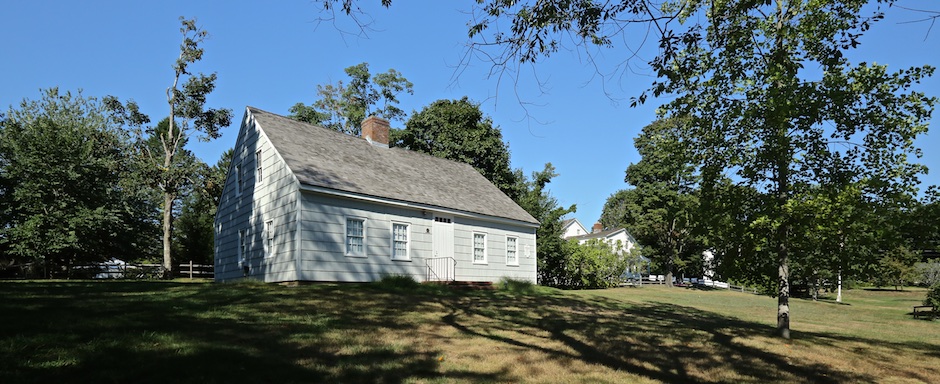
The Wickham Farmhouse, c. 1740
The Wickham Farmhouse, now situated on the Village Green in Cutchogue, is perhaps the most typical structure of its type. Its balanced facade and centered entrance with a simple row of transom windows over the door are marks not only of Georgian formality but also are unmistakable evidence of 18th-century construction. The roofline is unaltered and the eaves come right to the top of the main entrance facing. The floor plan is two rooms deep and the attic floor contains several sleeping chambers. The six-over-six light windows, the long-exposure wall shingles and the unbroken roof planes topped by the massive chimney present an accurate picture of colonial simplicity on Long Island….
— Houses of Southold.
————————————–
___________________________________________________________________

 Thomas Moore House, 1658-1750
Thomas Moore House, 1658-1750
As in the Wickham Farmhouse, the fine arrangement of doors and windows reveals a clear local understanding of Georgian design principles. The Moore House stands a bit taller than the Wickham Farmhouse, albeit with the same roof angle, typical of this style. The front of the roof joins the house at a higher point, well above the door and window frames. This extra height indicated a higher ceiling in the first-floor rooms. As a rule, the higher eaves tend to represent later 18th-century work….
— Houses of Southold.
—————–
Georgian Two Story Houses
While Southold’s favorite colonial style seems to have been the one-story Georgian house, two-story houses were also built. These show many of the features that were used in the one-story houses: well-proportioned facades, good-sized windows with small panes, and a center chimney. They also show their Long Island origins: long-exposure shingles, plain exteriors, and many additions over time. In the interior, framing timbers were visible, including the summer beam running from fireplace to end wall in the principal rooms. In many examples, the walls were paneled below the chair rail and plastered above. Customarily, the ceilings of the front rooms were also originally plastered….
— Houses of Southold.
___________________________________________________________________

Webb House, c. 1750
The Webb House was built as a two-story, Georgian-style Inn about 1750. Supported by columns, the roof extended beyond the facade to form a porch. Two principal chimneys penetrated the ridge of the roof, each centered about eight feet from its side of the building.
The internal plan of the Webb house strongly supported its early use as an inn. On both the first and second floors, two rooms flanked each side of the central hall. Downstairs, the front room to the right was a parlor and the front room to the left was a dining room. The rear rooms were kitchens. Upstairs, all four rooms were bedchambers.
Between the front room and the rear room, on each side of the house, the chimneys provided fireplaces in each room, a total of eight. Fireplaces in all the bedchambers strongly indicated the inn function, since ordinary homes did not usually provide fireplace convenience in the lesser chambers….
— Houses of Southold.
——————-
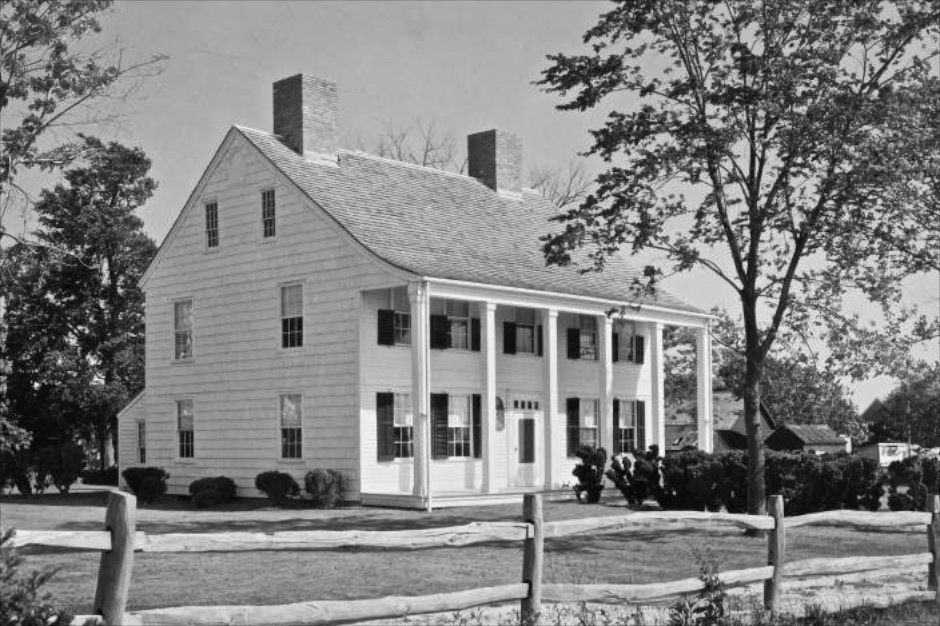
Webb House. Archival photograph courtesy of New York Public Library Digital Collection. Photo by C. Manley DeBevoise.
___________________________________________________________________
Benjamin Franklin Mile Markers, c. 1755
“About two years previous to this (journal entry), Dr. Benjamin Franklin passed through this island, from Brooklyn to Southold Harbor, and in a carriage of his own construction. It was so contrived, with clock work or machinery of peculiar make, that a bell would be struck at the termination of every twenty rods.” — Journal entry of Augustus Griffin, 1757.
The granite markers indicated the distance in miles from the Suffolk Court House (CH) in Riverhead, a measurement used to calculate postal rates. The first Mile Marker below is located in Cutchogue, twelve miles distant from the Suffolk Court House; the second, in Peconic, fifteen miles distant.
— Resource Information Provided by the Whitaker Collection, Southold Free Library
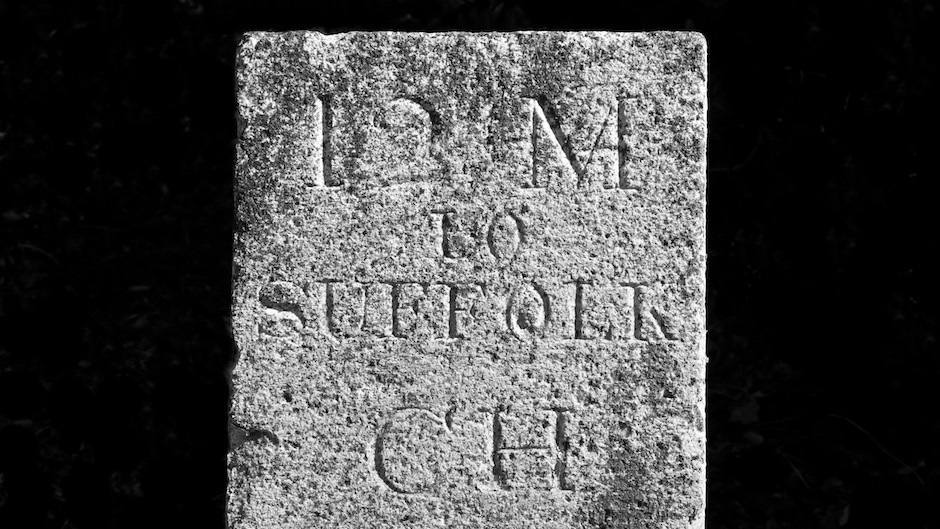
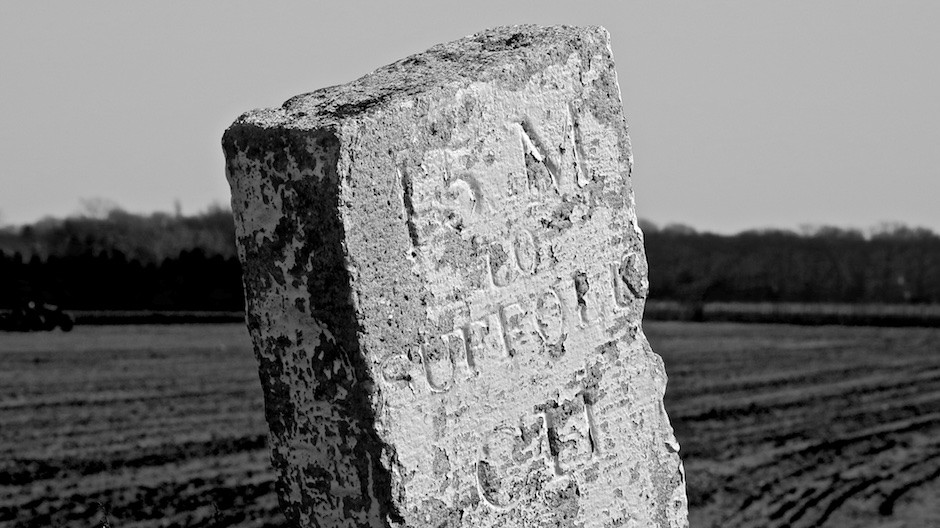
___________________________________________________________________

Orient Point Inn, 1796. Archival postcard, dated 1930, courtesy of the Southold Free Library Whitaker Historical Collection.
Famous visitors included Washington Irving, James Fenimore Cooper, Walt Whitman, Daniel Webster, President Grover Cleveland and Sarah Bernhardt. The Orient Point Inn closed in the 1960s and was later demolished.
___________________________________________________________________
Houses of the Nineteenth Century
~~~~~~~~~~~~~~~~~~
After the American Revolution, the search for a new “national style,” not derived from England, and particularly not Georgian, was begun by men like Jefferson, Latrobe and Bullfinch….Tradition was so strong and resources so meager that no new building form or style was introduce to Southold in the first forty years after the Revolution….
Lime for mortar had become generally available, plastered walls replaced panelling, and wood trim became broader and flatter than before. Factory-made butt hinges, secured with screws, replaced the common strap hinges and their nails. Fireplaces became smaller, and, responding to the influence of Count Rumford’s designs, shallower. Mantels were often flanked with decorative columns. Bricks were used for the visible portions of foundations, which were extended under the whole house….
—————–
Georgian Houses
So successful was the Georgian house during Southold’s 18th century that it was still a strong influence in the 19th century…Over the years, the Georgian house was adaptable to the influences of the times and changing ideas. The basic plan provided all the living space needed by the average family in an efficient and pleasing arrangement. When a new house style came into vogue, the earlier, basic house was readily adaptable to ornamentation in the new style…Were one to look carefully at many Southold houses, the basic elements of a Georgian house might be discovered clothed in later dress and hiding behind cherished embellishments….
— Houses of Southold
___________________________________________________________________

Howell-Kujawski House, c. 1800
This one-and-a-half Georgian house indicates by its elaborate entrance that it belongs to the mid-19th century. The sidelights and the large transom are surrounded by broad flat moldings typical of the Greek style. A more subtle indication of Greek influence is the narrow row of upstairs windows located precisely above the windows of the first floor and set between two horizontal bands. The bands with the windows and the spaces between suggest the wide frieze of a Greek temple….
–— Houses of Southold. Illustration by Joy Bear.
___________________________________________________________________
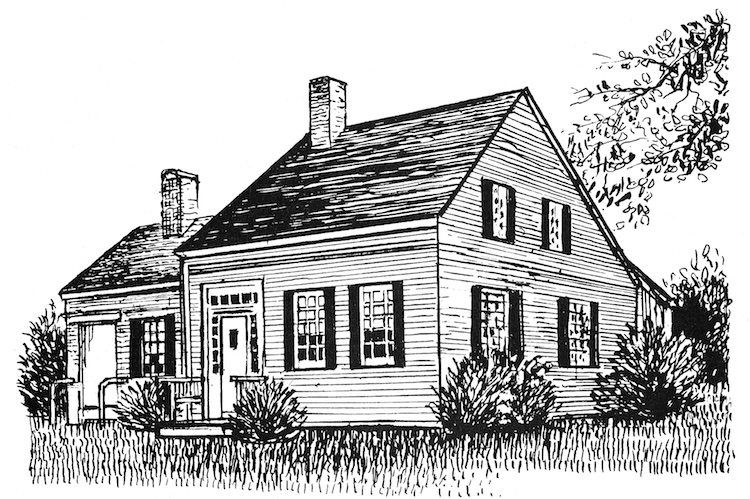
Kane-Schneider House, 1810
The Kane-Schneider House is one of several in Southold Town that date from the Federal era. The east wing of the Kane-Schneider house was added in 1850, when an expansion was needed. Many other half-houses were modified in similar fashion as the needs of their occupants grew.
The Kane-Schneider House possesses great integrity; the changes over the years have been few. The windows, the splendid door, the chimney with its two fireplaces and oven, and the floor plan are all original. The main entrance, with sidelights and transom lights, is the most dramatic evidence that this is a house from the Federal period, but more subtle is the presence of higher eaves and the clapboard cladding in the front. The back of the house and the sides were shingled in the fashion of the times.
Interior woodwork is typical of the early 19th century, with a fine chimney-piece with mantle surrounding the shallow fireplace. The interior window treatment includes panels beneath the windows that go to the baseboard, a high-style federal feature used only in the principle rooms….
— Houses of Southold. Illustration by Joy Bear.
___________________________________________________________________

Prelwitz House, c. 1814
As with the Kane-Schneider House, a pre-Revolutionary house form was made contemporary by the application of details that were current at the time of construction. On Long Island, the early decades of the 19th century were the heyday of the three-bay, side-hall house. This form was built in every hamlet from east to west, but it is virtually unknown in New England.
The Prelwitz House was a model of its type, including the gambrel roof and the subordinate wing to the right, which was also given a gambrel roof. The portico supported by Roman columns, covered a wide entrance with side lights. Its size required the off-setting of the center bay to preserve visual balance….
— Houses of Southold. Illustration by Joy Bear.
======================================================

Bay View School, 1822. Maple Lane Museum Complex, Southold.
The Bay View School – Built in 1822, the school was used for over 100 years before it was closed in 1925. Restored by the Southold Historical Society, it now once again receives students who participate in the Society’s educational programs.
======================================================
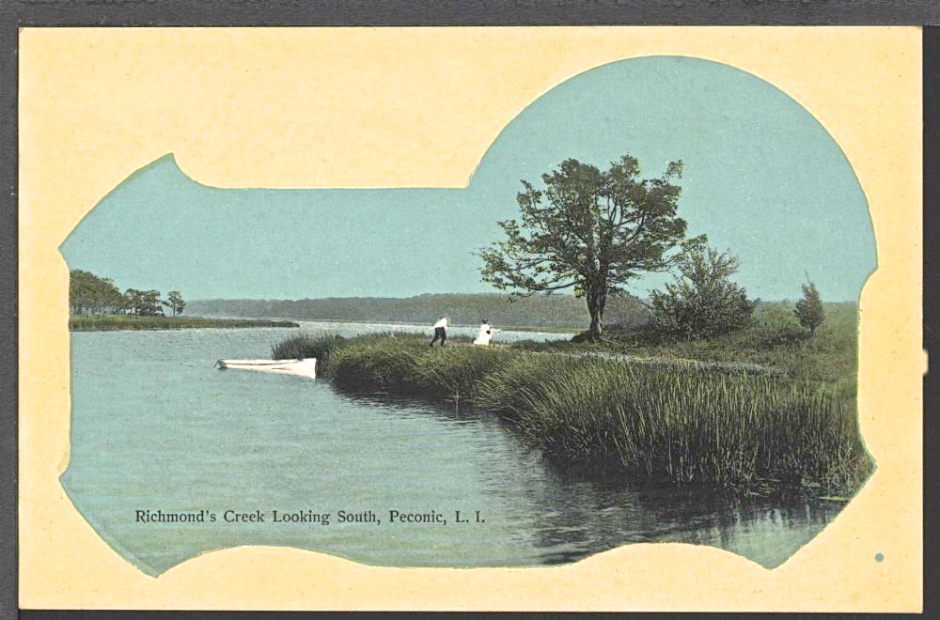
Archival Postcard courtesy of the Southold Free Library Whitaker Historical Collection.
======================================================
Greek Revival
The Greek Revival was the first of a series of romantic styles based on the historical architecture of distant cultures. The discovery, illustration and measurement of Greek ruins in the late 18th century excited the Western imagination….The Greek temple front, rendered in wood and painted white, was built in large numbers. The three-bay, side-hall house plan was used with a gable placed over the front facade. In the more classic representation, the roof was carried on freestanding columns to form a portico.
Local master builders, recognized for their design ability as well as their craftsmanship, became well known in Southold: Amon Tabor and William Cochrane worked and built in Southold Town in 1830-1840….
— Houses of Southold
___________________________________________________________________
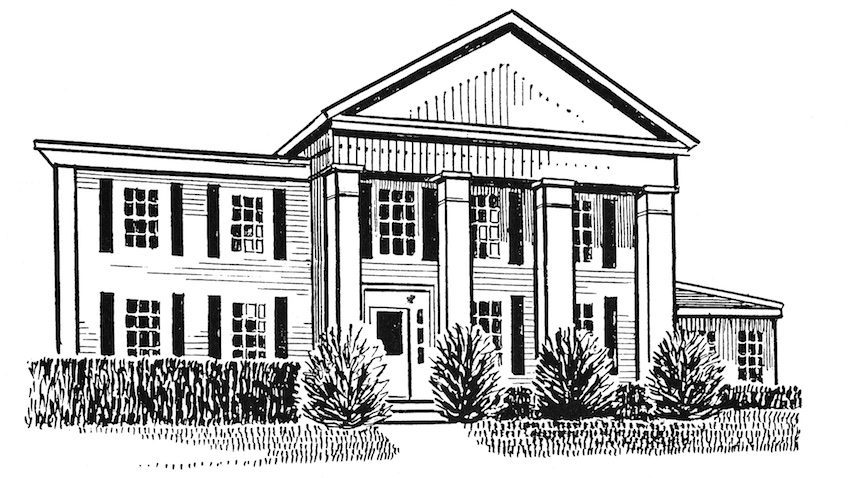
Townsend Manor, c. 1835
Townsend Manor is Southold’s only fully realized temple-front Greek Revival building, a style common in upstate New York but rare on Long Island. The full pediment, an accurate copy of a Greek design, done with flat boards to resemble stone, rests on four square columns. The shape of the space under the pediment is also square, echoing the classic Greek use of regular proportions in their buildings (the Greeks did not use the arch, and it is not to be found in Greek-Revival designs).
The two chimneys were located opposite the entrance and the stair hall. They served fireplaces in the principal downstairs parlors and in the two chambers above. The front entrance and the two large front windows in the main part of the house reflect the common architectural form of the house, the side-hall style.
Although the center of the house is square when seen alone, the overall impression of the building is influenced by the wing to the north, which carried the temple illusion to the observer.
The wings opened the possibilities of the floor plan, which in the front part of the building, was largely unchanged from its original layout. The rear portion and the south wing were later additions. They reflected the kind of change that the passage of time engendered in Southold houses. The preservation of the main part of the house illustrates the conservation that gives the Greenport community its historic character….
——————–
AAQ Resource: Townsend Manor Inn / Old Fashioned Hospitality
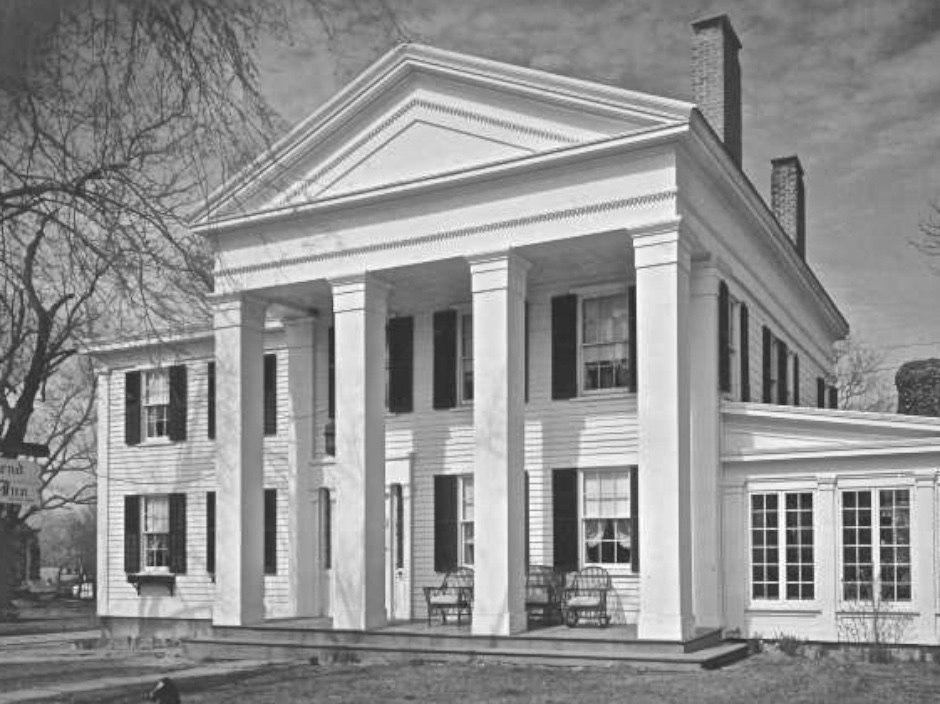
Townsend Manor. Archival photograph courtesy of New York Public Library Digital Collection.
—————————————-
Gothic Revival
Gothic Revival is often considered to be the first of the many 19-th century styles that are collectively called Victorian. Like the Greek Revival, Gothic was evocative of distant places and times, in this case, medieval England. It emphasized style over function in building design, as did the Greek Revival. However, while the Greek influence reoriented the Georgian rectangle from side-to-the-street to end-to-the-street and added simple decoration, the Gothic effect was a complex design of intersecting roofs, towers, bays, porches, carvings and finials…
While the Gothic influence usually is considered as a style change, the improvements in construction techniques that developed during that time helped to make its influence practical. The most important of these improvements was the invention of balloon framing. This new technique was the use of light, sawed lumber assembled into buildings, without the use of the heavy timbers needed in post-and-beam construction. The lighter, easily assembled framing eliminated the need for housewrights and the “raising” of main house frames, permitting buildings to be effectively and quickly constructed by less-skilled carpenters. The absence of the heavy frame freed the house from its need for a boxy shape, making irregular arrangements of many wings and levels possible.
Another change that helped make the new style practical was the introduction of the band saw. This made cut-out decorations inexpensive replacements of the hand-carved pieces that had been required earlier….The white painted shingles and trim that were acceptable in the Greek Revival style were replaced by a varied palette of yellows, browns, greens and reds that helped build the Gothic mood. Even roofs carried out the color ideals with the interaction of slate, which was shipped from Vermont on the new railroad….
— Houses of Southold. Illustration by Joy Bear.
——————————————————————————
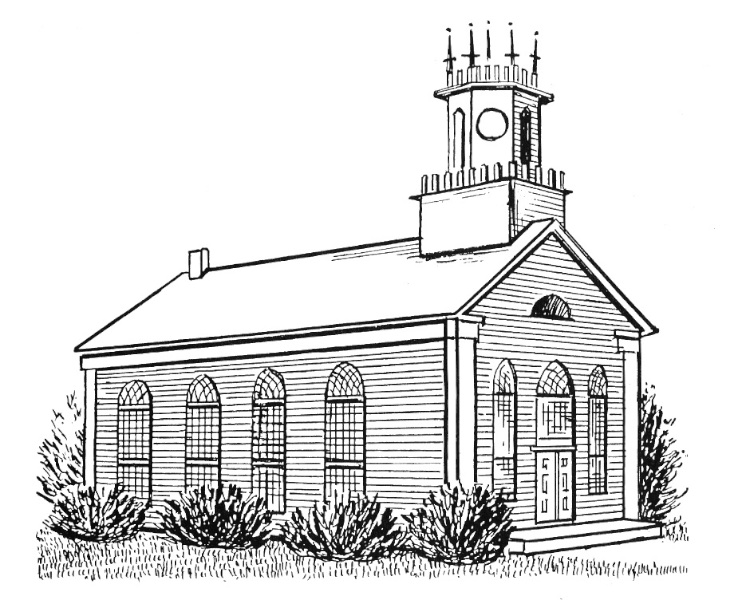
First Universalist Church, 1837. Designed by William D. Cochrane. Destroyed by fire, March, 2015.
The shape of the structure, the pitch of the roof, the corner pilasters and the color are Greek Revival. But the building is also the first Gothic building because of its great windows and many interior details. A major emphasis in the Gothic Style was a feeling of “up.” This is sometimes described as pointedness in the vertical sense, and the windows in this church clearly illustrate this effect. They carry the eye upward to the interlaced mutiny bars and the high cornice. The front center window is noteworthy for its mixture of Gothic and Palladian designs. The tower of the church further emphasizes the Gothic influence in its design. It offers an impression of medieval castle construction with a suggestion of parapets and flying banners.
— Houses of Southold. Illustration by Joy Bear.
——————————————————————————

Cutchogue Presbyterian Church Established for Abolitionist Members, 1862.
At the time of the Civil War, the Abolitionist members of the Cutchogue Presbyterian Church were asked to leave. There were offered land for a new church if they could get it ready in one year. Construction started in May of 1862 and the church was dedicated that October.
The style of the building was typical of churches in Southold in the middle of the 19th century. The Gothic influence is seen in the windows and the spire, with the main body of the church reflecting the earlier Georgian tradition of the community.
In 1887, the congregation went back to the first church. In 1913, the Cutchogue Library Association turned it into a library….
— Houses of Southold.
___________________________________________________________________
Italianate
As the Greek-Revival style passed from fashion during the decade of the 1840s, it was not entirely supplanted by the Gothic-Revival style. Another style, based on the architecture of the Italian country villa came into vogue. The houses were characterized by a basically cubic shape covered by a nearly flat roof. Vernacular Italianate houses had wide overhanging eaves supported by carved brackets, unadorned walls and large windows with two-light, double-hung sashes. Verandas ranged across the front, with decorated, square posts, flat roofs and bracketed cornices. The Italianate was used for larger homes, often with bays, a tower, paired windows and twinned chimneys….
— Houses of Southold
___________________________________________________________________
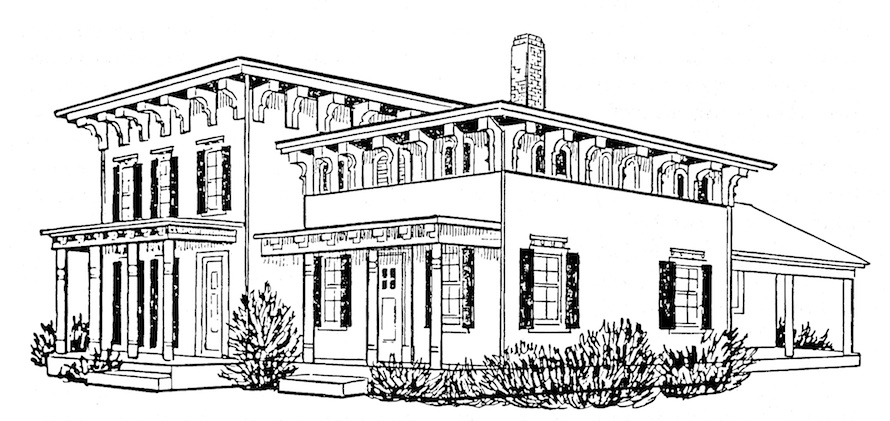
Ellsworth-Bond House, c. 1850
The Ellsworth-Bond House is a picture of 19th-century agricultural prosperity. Set in a vast lawn and surrounded by fields, its Italianate propriety is obvious. The house was built high and square, with the flat roof carried on heavy brackets. The pattern of the brackets and the eaves on the main house was repeated in the west wing and on the porches that covered the first floor of each section. Between the brackets, can still be seen, ornate, molded panels, which are the best examples of this art form in Southold Town.
Both parts of the house were three bays wide. In the main block, the second-story windows were predominant. They were hooded and flanked with shutters, while the windows of the wing’s second-story were set discretely between the roof brackets, as if to conceal them. This was the servants’ wing, with the kitchen and pantry on the first floor.
The Ellsworth-Bond House, and others of this period, placed greater emphasis on setting and view than those of the previous century when the sun, wind and general cast of weather were the major determinants for house positioning. This house faces north for the view rather than south to take advantage of the winter sun….
— Houses of Southold. Illustration by Joy Bear.
___________________________________________________________________

Brecknock Hall, 1857
Built by David G. Floyd in 1857, this mansion is remarkable for several reasons. The sheer size of the structure and its stone construction are unusual for Southold Town in the 19th century, and the style, while basically Italianate, is more accurately eclectic.
Floyd was a wealthy whaling merchant whose business was based in Mystic, Connecticut. His roots, however, were on Long Island and he determined to have a stone house where none had ever been built. Using Scottish stone cutters to dress the glacial rocks found on the large property, he built his stonehouse and had it trimmed with sandstone from Connecticut.
The design of the house incorporated the bracketed eaves, cupola and porch that are associated with the Italianate style. The massing of the sections of the house, together with the symmetry and the stonework itself are elements of the French Second-Empire style. The windows of the center section are Romanesque.This great house has been called “probably the most splendid Italianate house of the period in the country.”…
— Houses of Southold.
Every window had inside folding paneled shutters. All of the window and door framing plus the paneled shutters and all of the moldings were built and installed by Greenport ship’s carpenters and cabinetmakers. Fireplaces made expressly for David Floyd in Italy were in all of the principle rooms. Heirlooms of the Floyd family that included large mirrors with deep gold frames and magnificent chandeliers were brought up from colonial Washington, D. C.
— Dan McCarthy, Archivist at the Southold Free Library Whitaker Historical Collection and the Southold Historical Society.
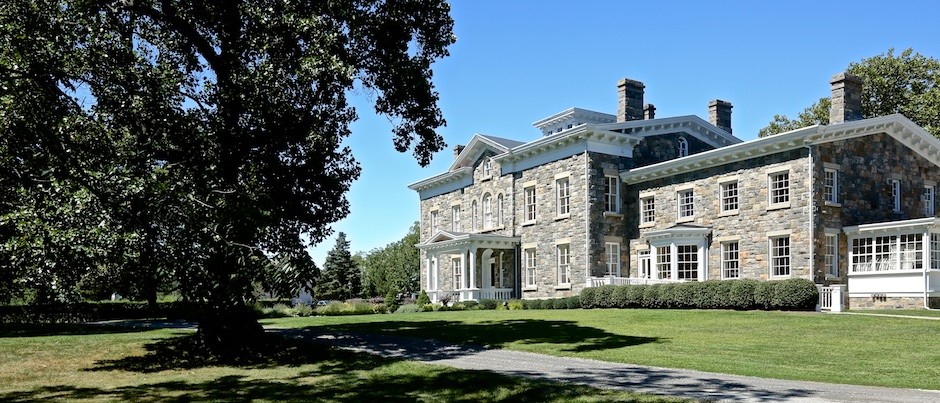
Brecknock Hall is one of Long Island’s most superb examples of 19th century Italianate stone architecture. It was constructed between 1851 and 1857 as the family residence for David Gelston Floyd (1802-1893). Floyd was the grandson of William Floyd, Long Island’s signer of the Declaration of Independence.
A prominent politician and merchant, David G. Floyd founded the ship chandlery of Floyd & Skillman in nearby Greenport where his own “personal” whaling fleet, including the ships Italy, Pioneer, and Prudent, was stationed. He named his new home Brecknock Hall in loving tribute to Brecknockshire, Wales, the ancestral home county of the Floyds.
— Plaque at site.
___________________________________________________________________
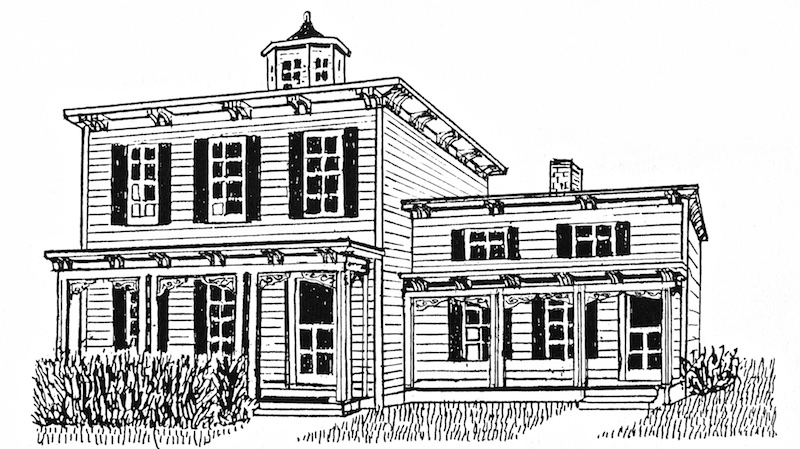
Cupola House, 1862
This example of the two-section, flat-roofed, Italianate house was built by the Vails, a fishing family in Orient. The style was very similar to the other Italianates built on large farm acreages in Southold Town. Here, however, the detail on the porch and the paired eaves-brackets were made of very fine scroll-saw work instead of the plainer decorations on other Italianates.
The cupola was of the same style and construction often seen in Italianate houses. A story sometimes given to explain the cupola is that it was a wife’s walk used to scan the sea for her returning, mariner husband. A more likely explanation is the use of the cupola for ventilation, particularly in the summer when the sun-heated flat roof made the ceilings of the upstairs rooms uncomfortably warm….
— Houses of Southold. Illustration by Joy Bear.
======================================================

HORTON POINT LIGHTHOUSE, 1857
– Commissioned by George Washington in 1790 –
The Horton Point Lighthouse, located north of Southold town, was constructed by the U.S. Lighthouse Service in 1857. The tower and adjoining keepers residence were built on the “Cliff Lot” of Barnabas Horton’s original 1640 land grant. The tower, which was originally connected to the residence by a cut stone wind-way, is 58 feet tall and once held a 3rd order Fresnel lens.
— Plaque at site.
————
The water surrounding the Horton property was called “Dead Man’s Cove” since the notorious and dangerous coast with rocky waters and sandbars made it difficult for ships. Record has it that in 1756, a young surveyor, farmer and soldier from Virginia named George Washington, of about 25 years of age, thought about the possibility of a lighthouse while traveling on the North Fork with Ezra L’Hommedieu, to be placed on the soundfront site overlooking the bluffs where the present lighthouse is located. The land was not available when Washington commissioned the spot during the time he was the first president of the United States in 1790.
The lot remained in the Horton family through six generations. It wasn’t until 1857 that the Horton Point Lighthouse was finished under the supervision of Scottish immigrant William Sinclair, who served as its first keeper.
The light station consisted of the 58’ tall square tower and a detached keeper’s residence. Both were constructed of New England granite and cut stone and locally acquired brick, timbers and lumber. The connecting tower between the tower and annex was added later.
— Dan McCarthy, Archivist at the Southold Free Library Whitaker Historical Collection and the Southold Historical Society.

Archival Postcard courtesy of the Southold Free Library Whitaker Historical Collection.
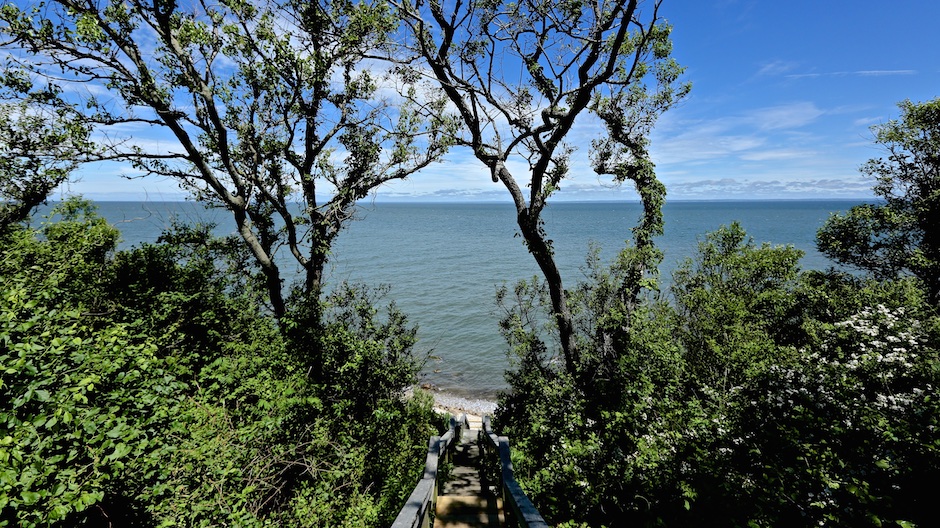
Stairway to the beach and Long Island Sound at Horton’s Point.
======================================================
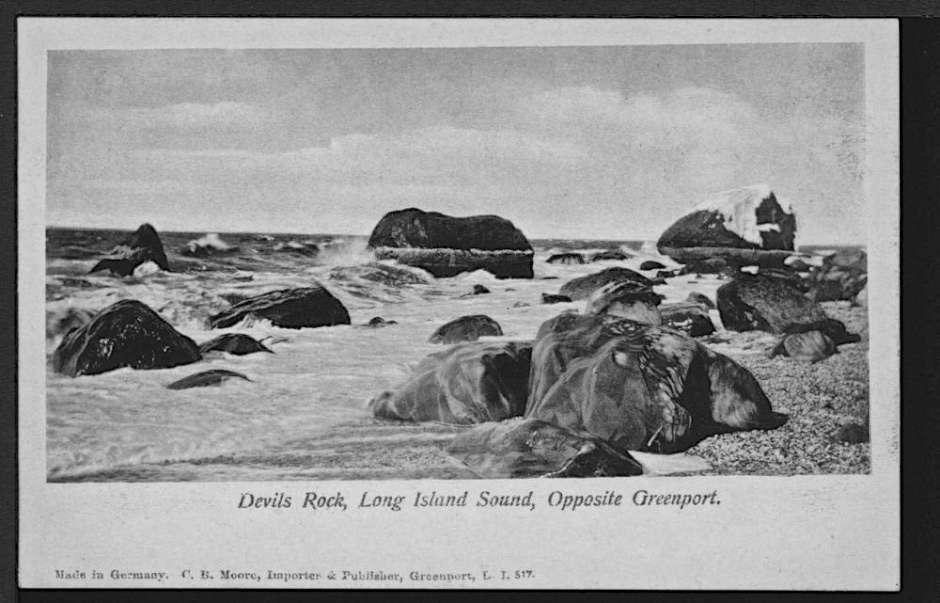
Archival Postcard courtesy of the Southold Free Library Whitaker Historical Collection.
======================================================
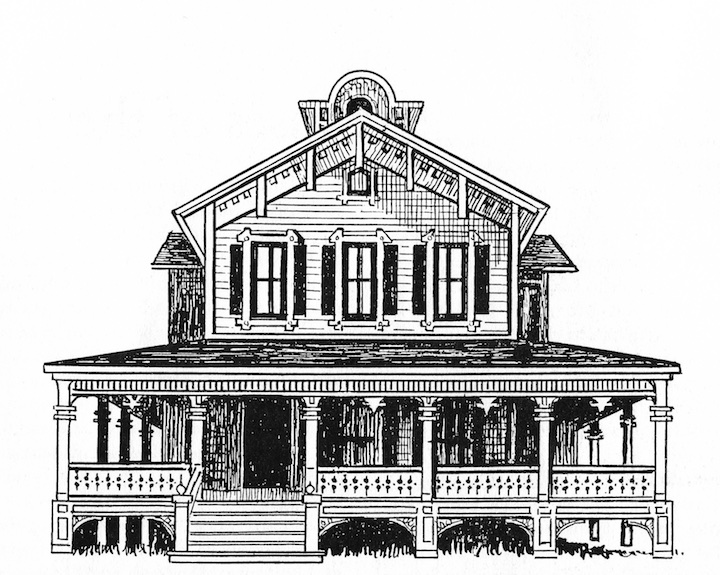
Dart House, c. 1870
This house was built by J.G. Case, a lawyer and Justice of the Peace. The style is one of the variations of the later Italianate, in that the roof brackets with dentils and the cupola are incorporated in the design. The roof is gabled and has a low pitch reminiscent of the Greek Revival style. The plan is that of a side-hall house which was used in both the Greek and Italianate styles. The large side wings, which carry intersecting gables, were seen originally in the Gothic Revival style.
The porch, a skillful product of the scroll saw and the turner’s lathe, wraps around three sides of the house. It is highly decorated, having a pierced frieze, square chamfered columns, pierced balustrades, and drops centered in the shallow arches between the posts. Such design suggests the incorporation of elements from many styles because of their individual appeal to the family who built and lived in the house….
— Houses of Southold. Illustration by Joy Bear.
___________________________________________________________________
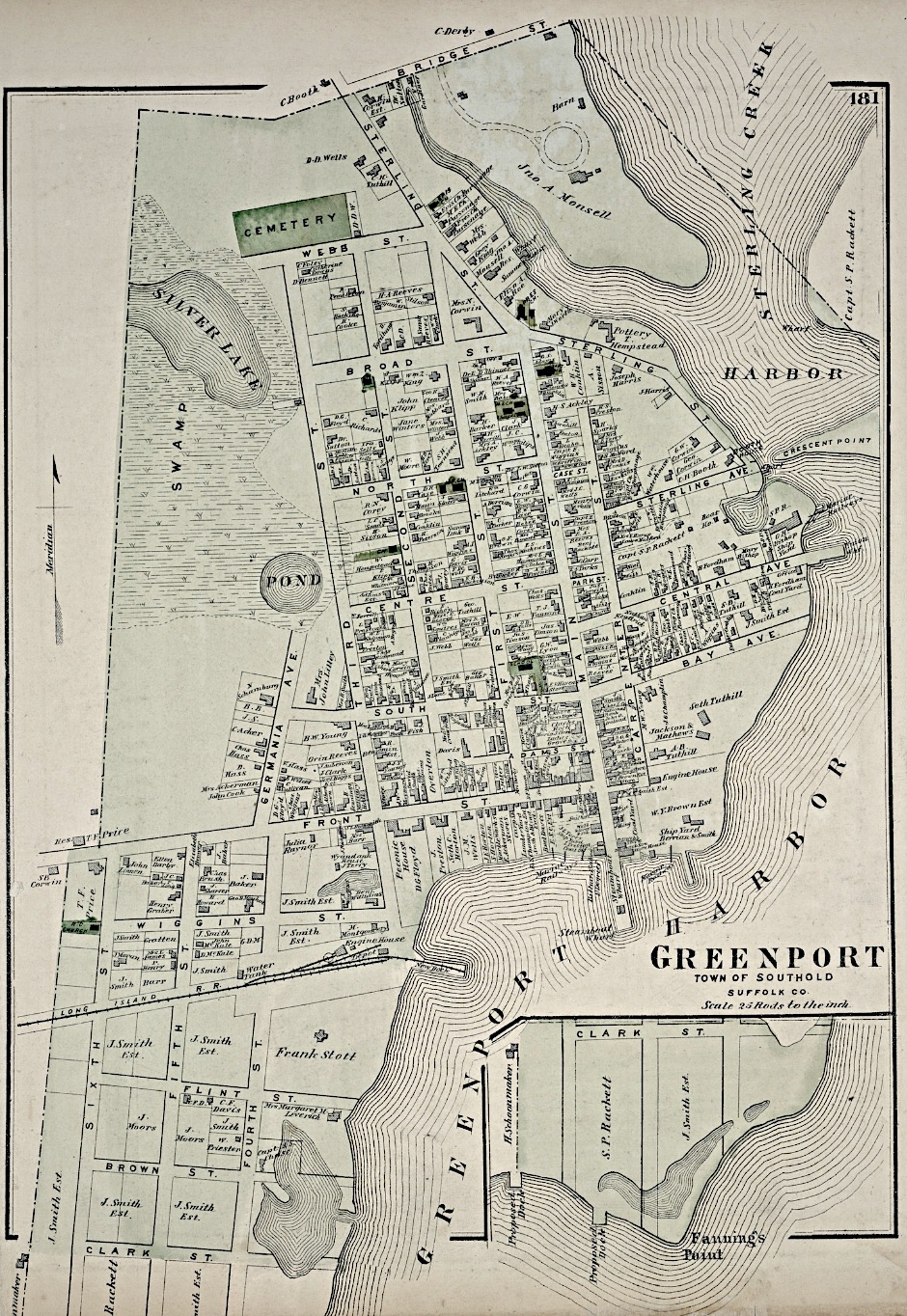
Map of Greenport, 1873. Frederick W. Beers, cartographer. Beers, Comstock & Cline, publisher. Archival map courtesy of the New York Public Library Digital Collection.
___________________________________________________________________
Victorian Era
Interest in Greek Revival never entirely disappeared when the Italian and French styles flourished in the middle of the 19th century, but the British exhibit at the American Centennial Fair in Philadelphia in 1876 redirected architectural efforts toward historic designs. The result was a period of mixed styles, often in the same building, termed eclectic. The principle English-derived styles of the eclectic period in the late 19th century were the high Victorian Gothic, the Stick and the Queen Anne. The general interest in architectural styles expanded from concern for buildings alone to include their settings, with emphasis on gardens and horticulture.
From 1870 to 1900 there were changes in construction as well as appearance. Balloon framing was universally applied and a variant, platform framing, replaced the older post-and-beam techniques. The availability of virtually every building material in lumber yards removed the necessity of timber shaping as part of the construction of a building. The house-wright disappeared, to be replaced by the carpenter who often worked from plans prepared by an architect.
Exotic materials, e.g. marble and tile for fireplace openings and mantels, slate for roofs, rare woods for floors, colored and stained glass, plated metals for roofing, gas light fixtures, porcelain plumbing fixtures and all manner of hardware, were available from specialized suppliers and were shipped all over the country by railroad. These new ways of implementing old needs freed Victorian architecture from the constraints of utilitarian construction. No longer were the finished houses the characteristic signatures of their builders and the traditional community. Instead they could be shaped and finished as complex artistic artifacts.
The major change for Southold in this period was the arrival of the summer residents from the New York City region by way of the Long Island Rail Road. Initially they vacationed in hotels or rented houses, but soon began to build large estates for summer occupancy….
— Houses of Southold.
___________________________________________________________________

Cox-Forman Carriage House, c. 1880
This building, originally erected as a carriage house, was converted to a residence in 1982. The building is probably the best example of the Gothic (Stick) style in Southold Town. Originally, a large section contained stables and a space for housing carriages. The far wing was used as a residence for the driver.
Appropriate to a style with long English roots, the wing is cross-gabled. Several double, round-headed windows, in individual dormers, bring light to the second floor. Brackets support a wide overhang with exposed stickwork over vertical boarding. The designer also gave the building a lofty spire to complete its highly original design. These elements, together with the dormers, offer a visible suggestion of the structure of a building in the best tradition of the Gothic style….
— Houses of Southold. Illustration by Joy Bear.
======================================================
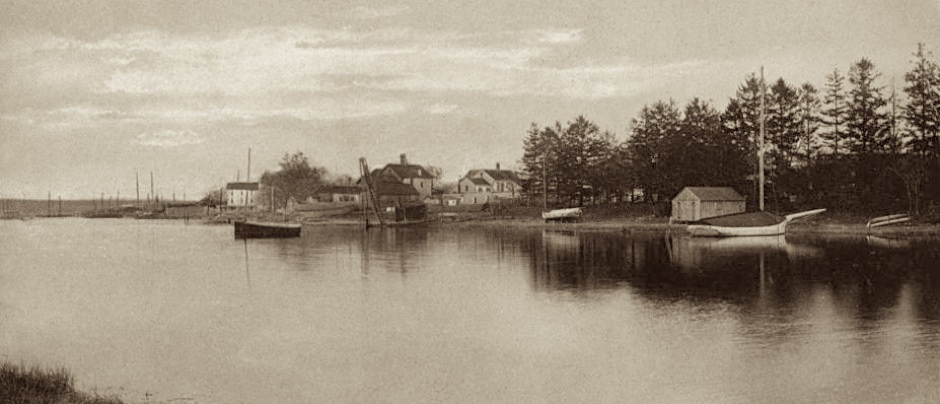
Archival Postcard courtesy of the Southold Free Library Whitaker Historical Collection.
======================================================

Mo-Mo-Weta, c. 1886
Mo-Mo-Weta was built by Frank Lupton, a native of this end of the island, who had amassed a fortune in New York City Publishing. It commands a fine view of Peconic Bay. The house illustrates a variation of the Queen Anne style, called Early Tudor Revival, which became popular for suburban houses in the early 20th century.
Like the earlier Stick style, the purpose of the vertical, horizontal and diagonal “beams” was to reveal the structural frame of the house. Unlike the framing of the early Tudor originals of the 15th century, these elements are merely wood designs set in stucco, instead of massive timbers infilled with plaster.
Mo-Mo-Weta was designed as a group of irregular blocks combined with many porches and dormers to maximize the view. Its asymmetry is emphasized by the gable within a larger gable and the large bay window set in the middle of the north wall that lights the main stair landing. The house presents an irregular and picturesque profile when viewed from any angle, and thereby successfully achieves one of the primary aesthetic objectives of the Queen Anne style. It is a fine example of Southold’s architectural heritage….
— Houses of Southold. Illustration by Joy Bear.
======================================================
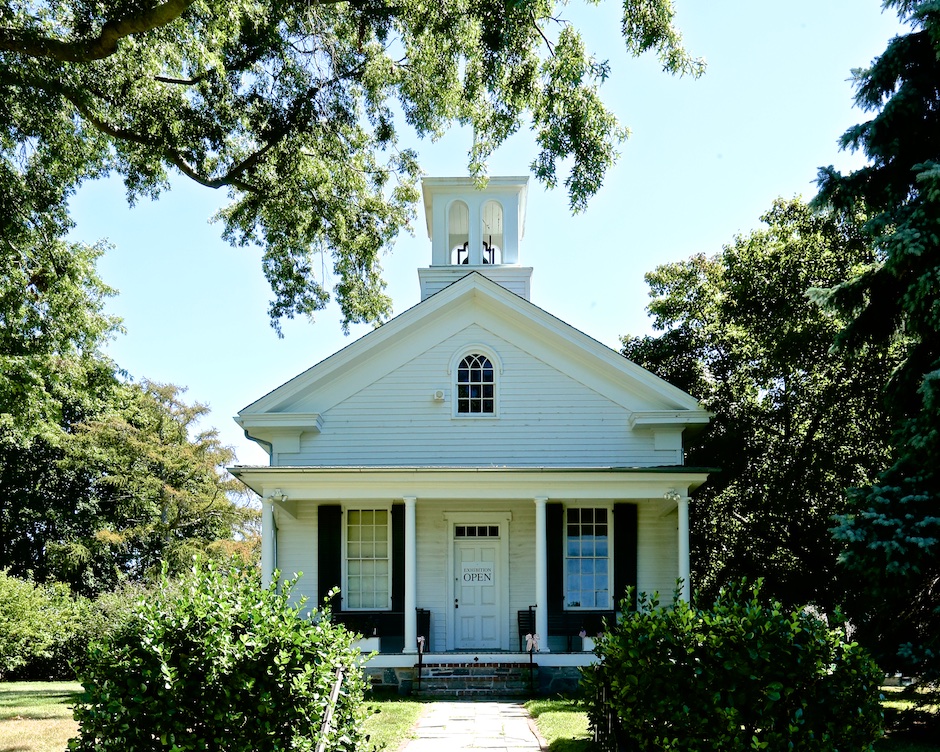
Orient Point Schoolhouse, 1888, Oysterponds Historical Society Museum Complex, Orient
Originally located on Orient Point about a mile from the end of the island (School District No.1). Affectionately called the “Down Neck Schoolhouse.” Abandoned as a school in 1930. The original cupola was destroyed by the Hurricane of 1938. Acquired and moved in 1949 by Oysterponds Historical Society to present site and restored.
— Plaque at site.
___________________________________________________________________
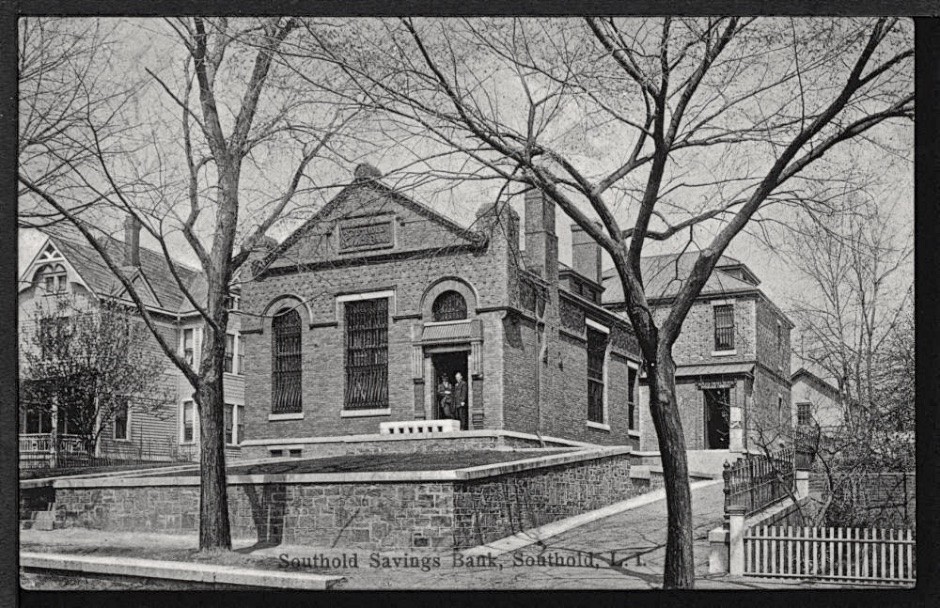
Archival Postcard courtesy of the Southold Free Library Whitaker Historical Collection.
The Southold Savings Bank, which opened in 1891, was designed by the well-known Riverhead architect, George Harrison Skidmore. Skimmer, active in Greenport as well as the county seat, was responsible for the design of some of the largest buildings and most lavish country homes in Suffolk County. For the bank in the center of the hamlet of Southold, Skidmore chose a uniquely American style named for the architect Henry Hobson Richardson who popularized it during the late nineteenth century. — Antonia Booth, Southold Town Historian, “A Community Achievement Updated,” The Story of Southold’s Libraries: 1797-1997.
——————–
In 1925 Edna Cahoon Booth bought the building presently occupied by the Southold Free Library from the Southold Savings Bank, which had moved to corner of Youngs Avenue and Main Road. She then transferred it to the Library in memory of her parents, Mr. and Mrs. Edward Cahoon. The library opened in the Cahoon Memorial Building on December 15th, 1928.
— The Story of Southold’s Libraries, 1797 – 1997
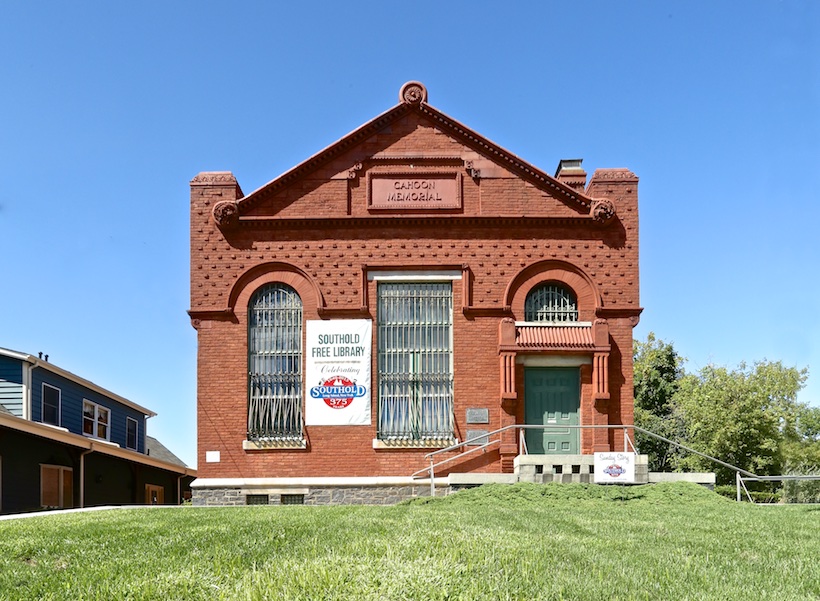
Southold Free Library, August, 2015
___________________________________________________________________
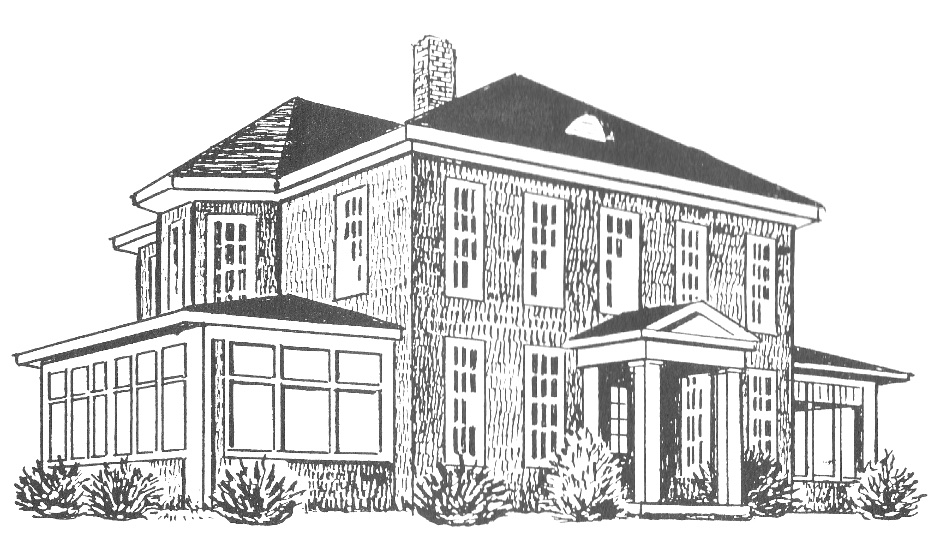
Ruch House, before 1897
The Ruch House was originally built just before the turn of the 20th century. It was remodeled to its present form in the early 1920s, when it was given the character of a four-square. At that time, the low hip roof was built and the entire house was shingled. A wrap-around porch on the front of the house was replaced by the present portico.
The four-square style usually is cubic in form but this house is more rectangular. The porches on either end emphasize the horizontal effect. The interesting feature that this house illustrates is the change from the Georgian style, characterized by the five-bay symmetry and the heavy horizontal feeling, into the four-square impression, given by the hip roof and the shingles.
— Houses of Southold. Illustration by Joy Bear.
___________________________________________________________________
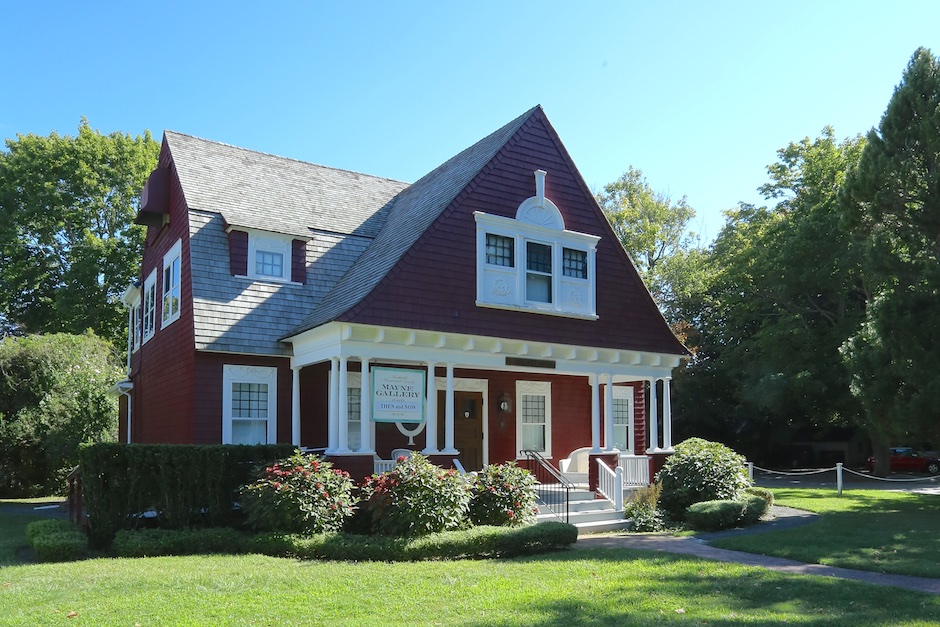
Joseph N. Hallock / Ann Currie-Bell House, 1900. Maple Lane Museum Complex, Southold.
The Joseph N. Hallock/Ann Currie-Bell House – Constructed in 1900 for Joseph N. Hallock, the house is a beautiful example of late Victorian architecture. The house contains much of the work of artist Thomas Currie-Bell (1873-1946), the husband of the founder of the Southold Historical Society.
New York State and National Registers of Historic Places.
========================================================================
Houses of the Twentieth Century
~~~~~~~~~~~~~~~~~~~~~~
The continuing growth and development of Southold in the 20th century demanded both replacement housing and new construction. The development of 20th century technology greatly altered and expanded the selection of styles that could be incorporated in new houses. Where styles based on European influence had served to enlarge the architecture of 19th century Southold, technical advances in design and materials became the controlling influences of the 20th century….
The new styles mad efficient use of the new building technologies: concrete blocks for foundations, wide exterior sheathing boards laid diagonally over the studs for stiffer structuring and better insulation, and in later houses, rock lath instead of wood lath for the interior plaster wall construction. Millwork for finishing was specified from a catalogue.
Standardized plans for houses of the Four-Square, Cross-Gable and other styles could be obtained for a few dollars from magazines. Local lumber yards could provide all the building materials, cut-to-size and ready to erect.
These houses, commodious and relatively inexpensive because of the economies of standardization, were often chosen when additional or replacement housing was needed on Southold’s farms. They are easy to see on the main roads, standing alone and surrounded by fields….
— Houses of Southold
___________________________________________________________________

Townsend House, 1905
The Townsend House is a fine example of a style, called Cross-Gable, that developed in Southold Town at the beginning of the 20th Century. Its form tells an interesting story of its architectural history. The main block is a three-bay side-hall house whose beginnings date to the late 18th century. The roof pitch echoes mid-19th century Gothic influence while the cross-gables reflect the vernacular Queen Anne style of the late 19th century.
The form of the Townsend House also tells about the history of domestic life in Southold in the 19th century. Because fireplace cooking and heating were made obsolete by cast-iron stoves, and plumbing brought running water indoors, the form of the kitchen changed. In the Cross-Gable style, a whole section of the house was provided for household services.
The basic house was standard, and was pictured and drawn in a builder’s design book. The variations were easy to visualize and select. The costs for basic choices and for the variations that individualized the house could be quickly evaluated from the accompanying material lists.
In looking for the Cross-Gable house style in Southold Town, the observer may find it interesting to count the number of variations that survive to enrich the heritage of our town….
— Houses of Southold. Illustration by Joy Bear.
======================================================

Visit: New Suffolk Waterfront Fund / Restoration Portfolio
————————–
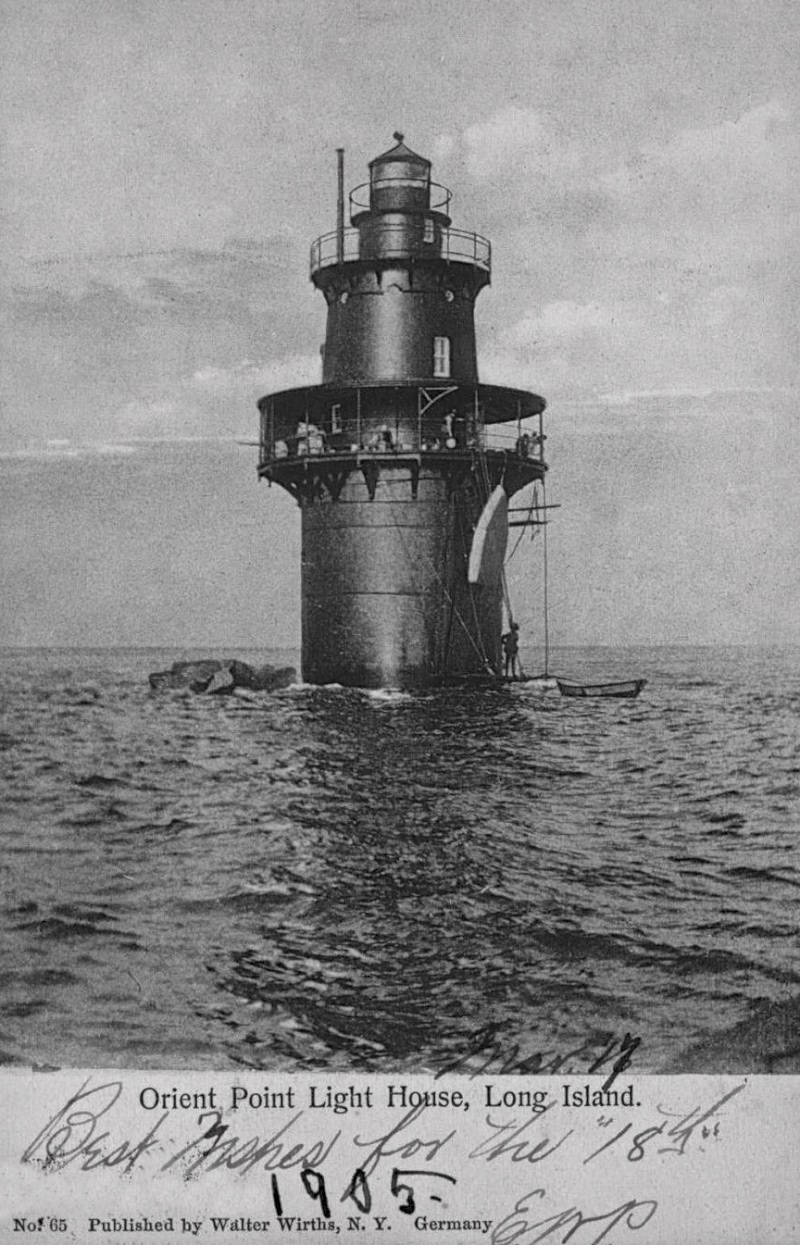
Archival Postcard courtesy of the Southold Free Library Whitaker Historical Collection.
————————–

Archival Postcard courtesy of the Southold Free Library Whitaker Historical Collection.
======================================================
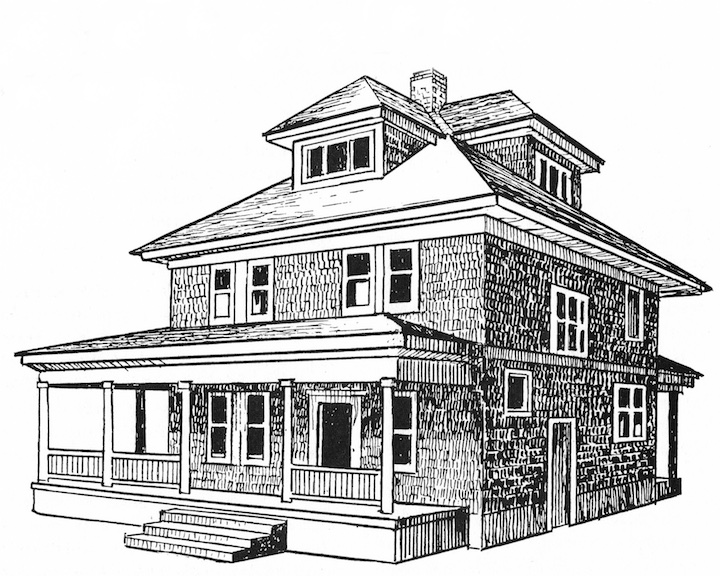
Monroe S. Burt House, 1906
The style of the Monroe S. Burt House is called four-square. It is one of the very few styles that are distinctly American in origin. The vernacular forms seen in Southold and many other areas were derived from the highly original work of Frank Lloyd Wright in Chicago beginning in the 1890s. These were popularized through the country by pattern books and builders magazines. Most of the houses of this style were built between 1905 and 1915. The four-square faded from fashion shortly after World War I.
These houses were characterized by a distinctly cubical shape, caped by a low-pitched, hipped roof with wide over-handing eaves. They were usually two-story buildings with one-story wings or porches supported on heavy posts. The windows were symmetrically placed and usually made up of square single-light sashes. Sometimes dormers, also hipped, projected from the main roof.
The construction of the Burt House tells much about house-building at the beginning of the 20th century. The availability of sized lumber and millwork, improved masonry, fasteners, finishing and utilities (plumbing, heating and in some parts of the Town, electricity) made it practical for a builder to sit down with a potential owner and design a practical, up-to-date, handsome house….
— Houses of Southold. Illustration by Joy Bear.
========================================================================

New Suffolk School, 1907
___________________________________________________________________
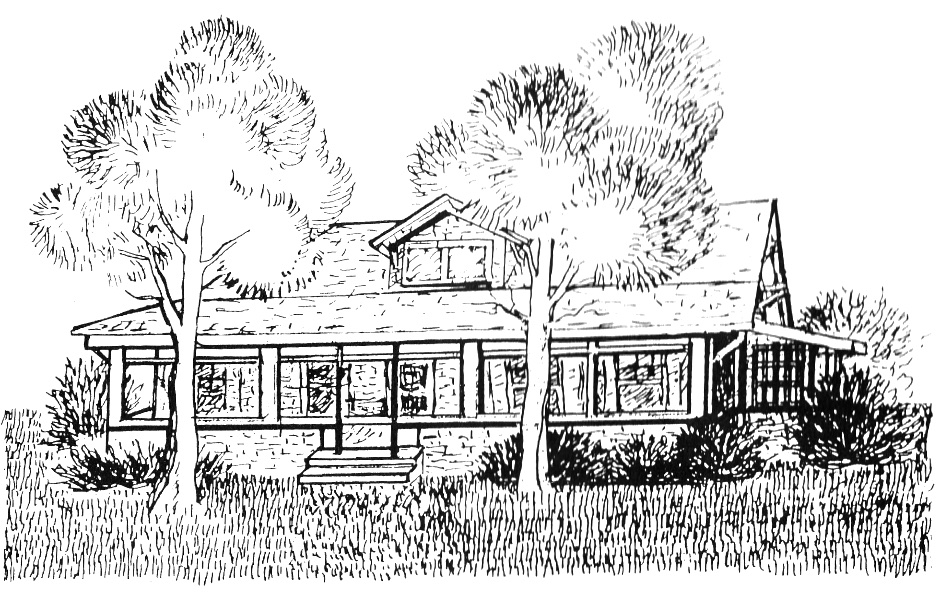
Summer Bungalow
By the beginning of the 20th century, Long Island had become a popular summer resort for New York…New summer residents called for new construction, and a new house style. The new style was the Bungalow. It was a particular example of the Craftsman style that emerged at the turn of the 20th century. Although the Bungalow was first built in California, it rapidly swept across the country, popularized by architectural journals and home magazines.
The Summer Bungalow was front-gabled, or more commonly, side-gabled. It usually had only one-story but used a large dormer to add the upstairs sleeping accommodations. There was always a large screened porch and sometimes a fireplace for the cool days of early and late summer.
The early Bungalows were built in Southold before commercial electric service was available. Water was pumped by hand and cooking was done on kerosene or coal stoves. As electricity and gas became available, summer living could be as convenient and comfortable as life in the city.
Many Summer Bungalows have been winterized. Set on foundations or cellars and insulated they became year-round homes. Often the improvements were made by second generation owners who retired to Southold, thereby recapturing the fond memories of their early summers.
— Houses of Southold. Illustration by Joy Bear.
~~~~~~~~~~~~~~~~~~~~~~~~~~~~~~~~~~~

Albert Einstein, Einstein Square, Southold. Sculpture by Marco Di Luca

___________________________________________________________________
WHITAKER HISTORICAL COLLECTION, Established 1940
Southold Free Library
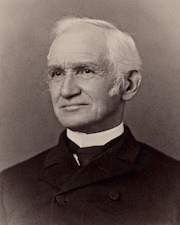
The Reverend Epher Whitaker, D.D., came to Southold as Minister of the First Church (Presbyterian) in 1851 as a young man of 31. He made his home here until his death in 1916 at the age of 96. During these many years, his relationship with the townspeople was one of mutual affection and respect. In addition to his ministerial function, he was an ardent historian who wrote and spoke about “the remembrance of things past.” He delved into the story of early Southold and authored, among other works and innumerable published sermons, eulogies, etc., The History of Southold’s First Century...
In order to give appropriate honor to this distinguished clergyman, a group in Southold in 1940 organized the Whitaker Historical Collection. The material was placed in the upstairs reading room and the Trustees at a later date gave formal permission that the collection might be left there….
Th purpose of the Whitaker Collection is described in a 1940 New York Times article as follows: “To give the factual history, genealogy and development of Southold Township through the 300 years of its settlement. The collection will be kept in a separate section and the items will be designated by a special bookplate.”
— The Story of Southold’s Libraries / 1797 – 1976 by Samuel Sander / 1797 – 1997 with update by Antonia Booth, Southold Town Historian.
The Whitaker Historical Collection is located in the Southold Free Library on the second floor in the Lucy Hallock Folk Room and is open Mondays, Wednesdays, and Fridays, from 1 to 4 p.m. or by appointment. Staff members Melissa Andruski and Dan McCarthy will be available to help. Lucy Hallock Folk was a highly contributing first librarian who helped organize the Southold Free Library Association in 1904. Serving as librarian from 1904 until 1909 plus being a trustee until her death in 1946, the second floor reference reading room in the library houses the Whitaker Historical Collection, and is named in honor of Lucy Hallock Folk.
Southold Free Library Adult Services and Programs staff member Melissa Andruski and archivist Dan McCarthy are available to offer assistance at the Whitaker Historical Collection. The Whitaker Historical Collection is open Mondays, Wednesdays, and Fridays, from 1 to 4 p.m. or by appointment.The main telephone for the Southold Free Library is (631) 765-2077.
Archival portrait of Reverend Epher Whitaker courtesy of the Whitaker Historical Collection.
———————————————–
==========================================================================
Editor’s Note: Many more houses & illustrations are included in the original publication, Houses of Southold, copies of which are available in the Southold Historical Society’s bookstore.
—————————————-
Resources
Selections & excerpts from Houses of Southold, Published by the Southold Town Landmark Preservation Commission, 1990, in celebration of the Town’s 350 Anniversary.
Archival postcards courtesy of the Southold Free Library Historical Whitaker Collection.
The Whitaker Historical Collection is open Mondays, Wednesdays, and Fridays from 1-4 p.m. or by appointment. Staff members will be available to help.
~~~~~~~~~~~~~~~~~~~~~~~~~~~~~~~~~~~~~~~~~~~~~~~
Please Visit / Click Logo:
~~~~~~~~~~~~~~~~~~~~~~~~~~~~~~~~~~~~~~~~~~~~~~~
Also Visit:
History of Southold / A Brief History by Antonia Booth (click here)
Maple Lane Museum Complex, Southold (click here)
Horton Point Lighthouse, Southold (click here)
Old House, Cutchogue (Click here)
Breckneck Hall, 1857, Greenport (Click here)
Webb House, c. 1740, Orient Village (Click here)
—————————————-
Photographs, other than archival, copyright Jeff Heatley.
___________________________________________________________


